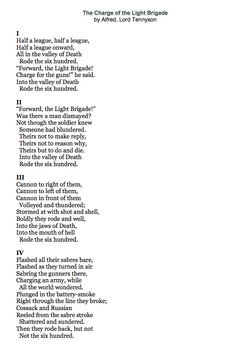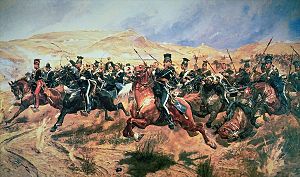

Vicious sibilance in ‘sabre-stroke/ Shattered and sunder’d’, creates a vivid and hellish sound through the uncomfortable alliterative ‘s’. through (terminology) suggests (MEANING) because (triplet of analysis). The noise of the battlefield is further replicated through onomatopoeic verbs such as ‘volley’d and thunder’d’. Tennyson in his Crimean War poem The Charge of the Light Brigade presents the. However, the use of rhyming couplets and triplets at sporadic points, such as ‘reply’, ‘why’ and ‘die’, reflect the energy and directness of bullets being fired. In Charge of the Light Brigade, Tennyson uses a tight rhyme scheme to symbolise the tight and relentless control the officers maintain over the soldiers. The Battle of Balaclava was part of the siege of Sevastopol, which lasted from 1854 to 1855. It took place in the 1854 Crimean War, during the Battle of Balaclava. The lack of a strict rhyme scheme alludes to the lack of harmony and disorder in war. The Charge of the Light Brigade was an attack by British light cavalry against Russian troops. The atmosphere is honourable, brave, and admirable. Rhyming couplets and triplets drive the poem forwards but they are often broken by non rhyming lines, this could mimic the stumbling horses and soldiers.

#Charge of the light brigade rhyme scheme full
It presents the truth of the chaotic nature of war despite misleading first impressions that it has some structure. Charge of the Light Brigade: Poem + Analysis ‘Charge of the Light Brigade’ is such a perfect, powerful poem it’s full of strength and momentum, that captures the movement of horses as they charge forwards into battle. Upon initial observation of the poem, the uniform stanzas separated into numbered sections may lead one to believe that war is ordered, however the content rebels against this notion. Tennyson portrays chaos through an amalgamation of techniques.


 0 kommentar(er)
0 kommentar(er)
